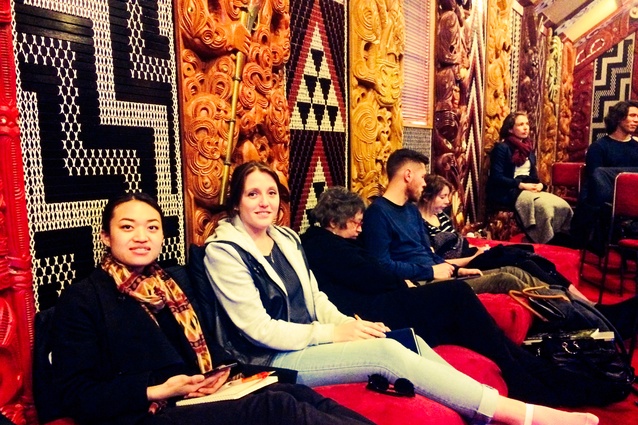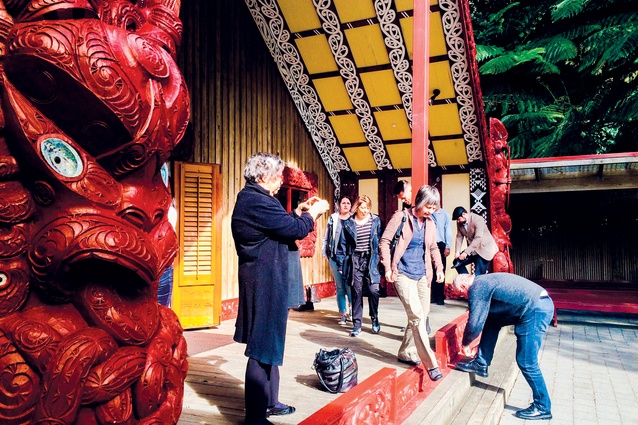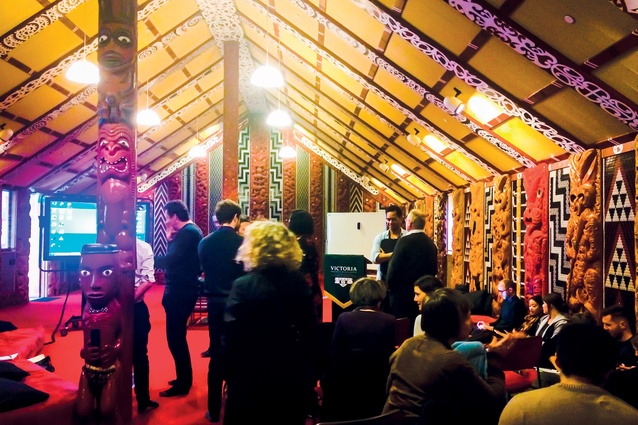Kore rawa e rawaka te reo kotahi: “One language is never enough”
A series of marae-based wānanga were presented in Auckland, Christchurch and Wellington as a joint venture between the NZILA and Te Tau-a-Nuku (the Māori Landscape Architects ropu). These workshops focused on the shared public environments that are the focus of most designers’ work.
Phil Wihongi (Nga Puhi), Alan Titchener (Ngāi Tahu) and Neil Challenger (Pākeha) – all three of whom are active in Te Tau-a-Nuku – along with local professionals, focused on strategies to achieve the goal of creating ‘culturally shared landscapes’ that speak Māori as well as speaking Pākeha.
Kathleen Kinney, editor of Landscape Architecture New Zealand, spoke with Neil Challenger, who, with Alan Titchener and Phil Wihongi, presented at all three wānanga; and Danny Kamo, principal of KamoMarsh Landscape Architects (Christchurch); Paula Hansen, a student at Lincoln University; and Melissa Weenink-Smith, Future Pathways manager at Otago Girls High School.
Kathleen Kinney: Neil, as one of the organisers of the event, can you tell us how this wānanga came about?
Neil Challenger: The Institute has never had an event like this before, and to some extent it was Phil, Titch and I talking and realizing we had this knowledge that we wanted to pass on. Our goal was to build on ‘why it matters’ and take it to ‘what do we do, and how do we do it’– the practical aspects of achieving this. So, in each location, we included local presenters who talked about specific local case studies, and the local Māori perspective – because nearly always with the detail, and sometimes with the big things, what is right in Christchurch wouldn’t be right in Auckland.
KK: Melissa, you’re a counselor and educator at an all-girls college. What inspired you to attend this event?
Melissa Weenink-Smith: I was on Facebook, and a ‘poster’ for the event showed up. I was instantly intrigued at the opportunity to learn from others that believe, as I do, that the environment, and our public spaces speak a language – most often, Victorian English. I believe the landscape and shared public spaces (inclusive of state schools) are an explicit reflection of power, ownership, dominance, and pervasive colonisation both subtle and deliberate.
KK: And what was your reaction?
Melissa Weenink-Smith: I was greatly relived to hear Neil speak of his distaste of the ‘Pou-a-fication’ (his term) of public spaces which he described as ‘lets pop in a couple of Pou, and some flaxes and that’s that!’ Neil and Alan clearly seek authentic, honest and moral engagement with Māori… I have such profound admiration for what the kaumatua of the profession have done.
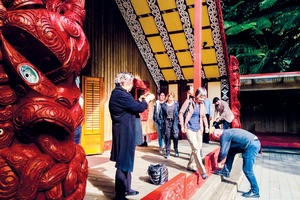
Danny Kamo: I thought the speakers and some of the projects discussed were fantastic. For example, Craig Pauling and Te Marino Lenihan – we work with them often and it was great to see some of their own work
KK: “The Culturally Shared Landscape”… what does that mean?
Danny Kamo: To me, it is a space that responds to and reflects the values of the many different cultures that use it. Different cultures will have different thoughts, responses and uses for a space so for a landscape to be truly culturally shared, it must be able to provide for these different needs, uses and values without one culture being more prevalent than the others.
Paula Hansen: My BLA degree and the Māori-focused papers I completed opened my eyes to the struggle Māori have had to be acknowledged in their homeland. To me, the willingness to acknowledge the many cultures of New Zealand is important. Although we need to give first consideration to the host Tangata Whenua iwi and then the culture of the local community and client, such as the Northland Dalmation community.
Melissa Weenink-Smith: I loved Neil’s presentation of Māori Principles of landscape design- ‘Te Aranga Principals’ the ‘mana enhancing’ guidelines from which to design a shared landscape: Rangatiratanga – Self-determination; Whanaungatanga – Relationships; Kotahitanga – Community; Wairuatanga – Spiritual Connections; Manaakitanga – Welcoming and Hosting; and Kaitiakitanga – Sustainable management.
Neil Challenger: If we agree that the physical world shapes behavior, then the way we design is very deterministic to our behavior. We need to acknowledge that some ‘landscapes’ are, by nature, not shared spaces. Māori sites – marae, wharekura – only need to be Māori; just as a Catholic church or a Buddhist temple only has to fulfill the needs of Catholics or Buddhists.
But the public domain is shared, and needs to acknowledge and be welcoming to all – Manaakitanga. To give a really basic example, ‘welcoming’ means including things like drinking fountains that children can reach, sufficient places for the elderly to sit, perhaps a spot to share a meal, and signage that can be understood by the community that shares that public space.
KK: Is this ‘culturally shared landscape’ something unique to Aotearoa New Zealand?
Neil Challenger: New Zealand is in a unique position as a colonized country, because we have about 16-17% indigenous population; and, in some towns, over 50%. We also have the Treaty of Waitangi; and the indigenous people of New Zealand are united by common language. So we have a pretty special situation here. These wānanga were very much about Māori and Pākeha in this country and how these cultures can share the landscape, which – given the hegemonic position of the Pākeha culture in the landscape – inevitably meant that we came to focus on issues and techniques of meeting Māori cultural needs in the landscape.
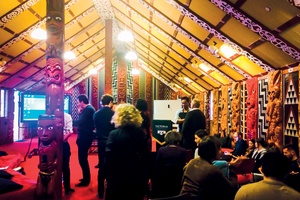
Danny Kamo: I think this issue goes beyond New Zealand. Not only have many other countries tried to include the indigenous culture of their land but, also, as immigration continues to increase around the world, creating culturally shared landscapes will have increased importance.
An array of diverse people will be seeking visual reminders of home in a new, shared space; and they will need a landscape where traditional and non-traditional homeland activities can be continued. Designing culturally shared landscapes will be an increasingly significant topic for our industry.
KK: Was there anything specific that you hoped would be addressed or discussed at these workshops?
Paula Hansen: I was seeking inspiration on how to create a community centre that would accommodate the processes of the powhiri without screaming ‘marae’, as it needed to be used by many cultures. As a non-Māori, I was having trouble finding information online and in libraries about incorporating Māori processes into a design (history but no guidelines) and needed clarification. I came away with the understanding that we don’t need to stick a pou and koru into every design to reference the indigenous landscape. All I needed to do was ask my friends and the Māori staff of Lincoln University.
KK: What do you see as the next step?
Melissa Weenink-Smith: I applied for funding to engage a local Kāi Tahu artist to work with students to co-create a sculpture that would be placed in the environment, along with a space that promoted reflection and appreciation of this expression of culture. This is something I could potentially help make happen. I learned about Te Tau-a-Nuku and that there is a need for many more Māori to enter the profession. I intend to promote this through my school, particularly to young women that enjoy art and science and of course to our young Māori students.
Danny Kamo: The idea that these are not a one-way meetings is important to remember. We (as designers) are not just going along to ‘take notes’, it is good practice to have started the thought process prior to meeting with runanga or other groups. Ultimately we need more consultation, open discussion and understanding.
Neil Challenger: Te Tau-a-Nuku was pleased by the success of the three wānanga. But there is a lot more to do. It would be good to have a wānanga focused around planning in both the strategic and the statutory sense of the word. Landscape architects need to have the confidence to paddle the waka on every project, even if its just a few strokes; and I think this means they need more cultural knowledge and capability, so there is work to do in this area.
We have the power to contribute significantly to shaping the landscape in a way that will inclusive, richer and uniquely from New Zealand – and perhaps even from Aotearoa.

